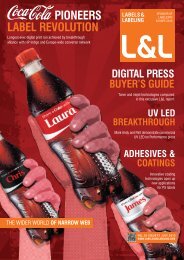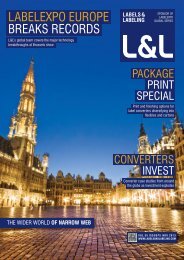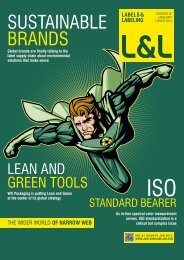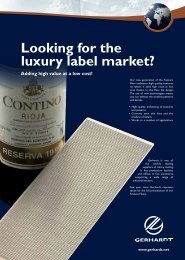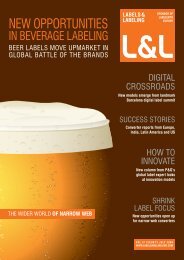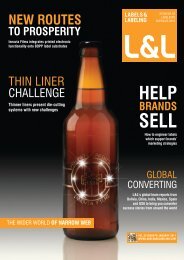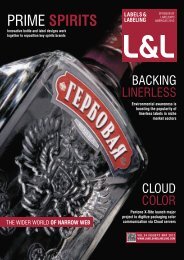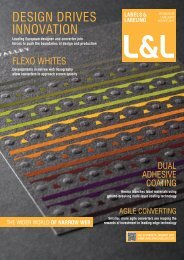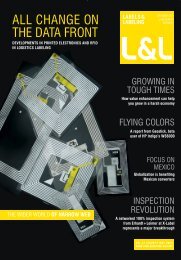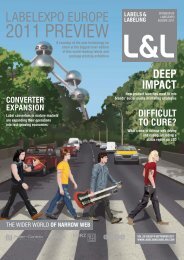Create successful ePaper yourself
Turn your PDF publications into a flip-book with our unique Google optimized e-Paper software.
LABELS&LABELING |19<br />
OKI press fits<br />
digital gap<br />
LAUNCHED LAST YEAR, OKI’s proColor pro510DW<br />
digital press has found a niche between the entry<br />
level and bigger industrial digital label presses.<br />
Danielle Jerschefske reports on an early installation<br />
OKI Data Americas has reported the first installations of its<br />
proColor pro510DW roll-fed digital label press – part of<br />
the proColor Series of digital printers – launched in<br />
mid-2011.<br />
Electrophotography is the core foundation of OKI<br />
Data digital print technologies, as it is with both HP<br />
Indigo and Xeikon. The press uses a drum and toner<br />
model with LED imaging for smaller dot production and<br />
print clarity. Its consumables are based on OKI dry toner that<br />
adheres to a drum roll where the image area charge is neutralized<br />
by small LED printheads. The image is then transferred from the<br />
drum to the media. The company’s Microfine Spherical Toner<br />
chemistry is claimed to deliver a high gloss and smooth tonal<br />
gradations.<br />
The OKI pro510DW digital web press has four color stations and<br />
a print width up to 12.9 inches. It runs up to 30 ft/min (10 m/min)<br />
with fully variable data where required. A three inch core holds up<br />
to 300 feet of material.<br />
The press is equipped with auto insertion hardware and software<br />
that allows converters to ‘cut-on-the-fly’, so when multiple jobs are<br />
run on a single roll, each can be cut and cored while the material<br />
is automatically held and set for the next run. This frees up the<br />
operator from manual intervention.<br />
Currently machines are delivered with a Compose front end<br />
based around a Harlequin RIP, which handles color management,<br />
workflow, media type and cost estimates. It can print<br />
pre-converted labels or labels can be finished on a wide range of<br />
off-line cutting systems.<br />
‘With a small footprint and low investment cost, this OKI system<br />
can bring great value to a small converting business,’ says Rich<br />
Egert, GM of strategic technology partnerships (STP), part of the<br />
new business development group that leads the graphic arts and<br />
production division of OKI Data Americas. ‘The pro510DW is ideal<br />
for promotional runs within a full service flexo house giving the<br />
capability to complete short run, profitable, high quality solutions<br />
for less than 15,000 labels.’<br />
PROFITABLE ROI<br />
Tim Newton is the manufacturing director for Thomco Specialty<br />
Products & Converting in Suwanee, Georgia, a company that<br />
distributes a wide variety of materials for industrial markets<br />
like automotive, aerospace, offset printing, signs and graphics<br />
and metal shops. The company also creates complex custom<br />
converting solutions for applications including testing, design,<br />
prototypes, and manufactured parts.<br />
Thomco currently uses Roland UV and solvent inkjet technology<br />
to print small quantities of decals on vinyl substrates, mostly<br />
for prototype and testing work, using tool-less dies to cut the<br />
materials. This business has expanded exponentially for Thomco<br />
over the last five years, and led the company to expand its digital<br />
offering with an OKI Data pro510DW digital web press to support<br />
its flexographic label production.<br />
Most of the work coming off the OKI press is sheeted, with<br />
cutting done off-line using a tool-less die flatbed plotter. The<br />
converter estimates that it must be printing 700-1,000 feet of<br />
labels to justify the cost of finishing labels in rolls.<br />
Explaining the thinking behind his digital investment,<br />
Newton says, ‘We had to be able to justify the spend on the<br />
equipment. The OKI system and its technology are appropriate<br />
for our current needs and the investment cost fair for the<br />
expected ROI.’<br />
Thomco ran an assessment between a Xeikon system and<br />
the OKI platform using the same image before a decision was<br />
made. ‘When we reviewed the two runs, we felt the quality was<br />
eighty percent of a Xeikon, while the cost of the OKI system is<br />
only 10 percent of the price of a Xeikon. And while the OKI press<br />
isn’t high speed – it’s a similar speed to entry level competitive<br />
systems and about half the speed of higher end models in the<br />
marketplace – we don’t really care about that right now.’<br />
The pro510DW is producing runs at Thomco up to 5,000 feet,<br />
in three- and four-color process work with multiple SKUs that<br />
are simply too costly to take-on with flexo. The converter has<br />
been able to call on small accounts where it previously could<br />
not compete - for example producing 250 labels for a chemical<br />
spray, with three flavors that required three-color work. Thomco<br />
has validated and standardized substrates into five general<br />
groups: board eight to 13pt, matte paper, gloss poly, matte poly<br />
and matte vinyl.<br />
Newton concludes that the OKI system does a very good job,<br />
and is likely to pay for itself within six to 12 months of operation,<br />
given current workload and usage.<br />
JULY 2012 | L&L<br />
OKI pro510DW digital web press for labels



